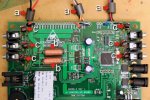jedynakiewicz
Senior Member
Interference suppression for small D.C. Motors
A lot has been written on this forum regarding decoupling ICs and the suppression of interference from small electric motors. The standard 220nF capacitor across the motor brushes seems to work in most cases...but not all. It strikes me that the vast majority of threads deal only with capacitative suppression; inductive suppression is not often mentioned. With this in mind I opened the casing on a Scalextric Digital set to see how the professionals deal with the spectacular level of interference from the often rather rough motors engaging with the track through sparky pieces of copper braid. Apart from the expected ceramic capacitors across the tracks, I found no less than eleven inductive devices that appear to be there to suppress interference. I have photographed the board and marked up the inductors.

There are ferrite beads (a) slipped over the power output leads to the tracks and to the opto-switchs that detect the passing vehicles. There are ferrite chokes (b) on the power outputs to the tracks. There are inductors (c) with three turns of enamelled copper wire in the leads to each hand controller. Eleven inductors in all!
I have the impression from this forum that not a lot of PICAXE users are employing inductors as well as capacitors to suppress interference, but it seems industry does. Before I go and buy a sack-load of ferrite, would some of our experts provide a commentary on this subject? It would be most appreciated.
To simplify the "quote and reply" function of this forum, may I ask for comments in these specific areas:
A lot has been written on this forum regarding decoupling ICs and the suppression of interference from small electric motors. The standard 220nF capacitor across the motor brushes seems to work in most cases...but not all. It strikes me that the vast majority of threads deal only with capacitative suppression; inductive suppression is not often mentioned. With this in mind I opened the casing on a Scalextric Digital set to see how the professionals deal with the spectacular level of interference from the often rather rough motors engaging with the track through sparky pieces of copper braid. Apart from the expected ceramic capacitors across the tracks, I found no less than eleven inductive devices that appear to be there to suppress interference. I have photographed the board and marked up the inductors.

There are ferrite beads (a) slipped over the power output leads to the tracks and to the opto-switchs that detect the passing vehicles. There are ferrite chokes (b) on the power outputs to the tracks. There are inductors (c) with three turns of enamelled copper wire in the leads to each hand controller. Eleven inductors in all!
I have the impression from this forum that not a lot of PICAXE users are employing inductors as well as capacitors to suppress interference, but it seems industry does. Before I go and buy a sack-load of ferrite, would some of our experts provide a commentary on this subject? It would be most appreciated.
To simplify the "quote and reply" function of this forum, may I ask for comments in these specific areas:
The need to use ferrite beads on leads connecting into/out of microcontroller circuit boards
The use of ferrite chokes on motor leads - How many microHenrys? How do you select the right choke?
Last edited:
